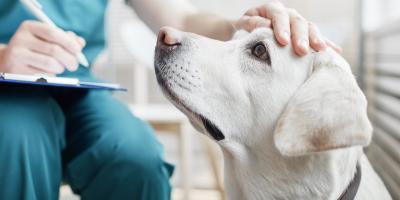Urinary infections in dogs are very common, and just like when it happens to us humans, it can be unpleasant and quite painful because of the burning sensation when urinating. Luckily, once you’ve taken your dog to the vet for diagnosis and treatment, these infections will clear relatively quickly, and your canine friend will soon be back to their usual self.
If you’re wondering about the symptoms of urinary tract infections (UTIs) in dogs and want to know the treatment options available, keep reading as we’ve put together this handy guide with everything you need to know.
What Are Urine Infections in Dogs?
A urine infection in a dog is an infection of the urinary tract, making it uncomfortable to pass urine. Your dog may strain when urinating and their urine may contain blood. These UTIs are commonly caused by bacteria including E. coli, but some fungi may also cause an infection. UTIs can also be caused by bladder stones, and incontinence in older dogs could also lead to an infection.
Surprisingly, urinary tract infections in dogs are more common than you’d think. According to American Kennel Club, it’s one of the most common infectious diseases in dogs and around 14% will be affected by this problem at some point in their lives.
Are Some Dogs More Predisposed to Urine Infections Than Others?
Any dog can get a urine infection, but there are some which are more likely to be affected. Older dogs are more likely to get them, as are female dogs because they have shorter urethras. Additionally, dogs with pre-existing health conditions such as chronic kidney disease and Cushing’s disease are more at risk of getting a dog urine infection.
Symptoms of Urine Infections in Dogs
If your dog has a urine infection, they may display some of the following signs:
- Difficulty urinating – they may appear like they’re straining and might whimper
- Urinating frequently – they may also dribble urine
- Forgetting their housetraining – they might start urinating in the house again
- Blood in dog urine – it may appear as a pinkish color or be cloudy
- Frequent licking – they may constantly lick around the urinary opening
- Fever – your dog may feel hot, and a fever may be present
- Bad odor – the urine may also have a strong smell to it
- Increased thirst – due to the more frequent urination, your dog may drink more often to try and restore their bodily fluids
- Fatigue – your dog may seem more tired or sluggish than usual
If you suspect a dog urine infection is present, take them to the vet for a diagnosis. When left untreated, these infections can cause problems such as lower urinary tract dysfunction, kidney or bladder stones, blood poisoning and even a kidney infection in more serious cases.
Diagnosing Urine Infection in Dogs
The vet will ask for details about your dog’s symptoms, and then they will conduct a full examination which may include taking a urine sample which they may culture to help identify any bacteria that are involved.
Treatment of UTIs in Dogs
Once your vet confirms it’s a urine infection, if bacteria are thought to be responsible, it’s usually a simple case of prescribing the correct antibiotics to clear up the infection.
Luckily, once this treatment has been administered, the symptoms will generally clear up relatively quickly.
To ensure that your dog gets back to full health quickly, it’s important for you to keep up with the recommended amount of antibiotics for the allotted time your vet has told you. Stopping treatment too early could cause the infection to reappear. If your dog’s urine infection seems to be hanging around for too long, go back to your vet and they’ll be able to look at an alternative method of treatment.
Preventing UTIs in Dogs
There’s no cure for UTIs in dogs but there are some simple steps you can take to reduce the risk of your dog getting one, as follows:
Ensure your dog always has access to plenty of fresh, clean water.
Let them outside often to relieve themselves so they’re not forced to hold urine for too long.
Keep their private regions clean. If you have a long-haired dog it may be a good idea to keep the feathering around their rear end cut shorter as this prevents the fur from becoming soiled, thus reducing the risk of infection.
The important thing is that if you suspect your dog has a urine infection, take them to the vet straight away. UTIs in dogs can be painful and uncomfortable, so it’s important to get them treated early so your pet can go back to being the happy and healthy dog you know and love.
For more tips from Purina experts on how to look after your dog’s digestive health, explore our other dog digestion articles.
Related articles

Reward Yourself with myPurina
Earn and redeem rewards for Purina products with the myPurina app.








